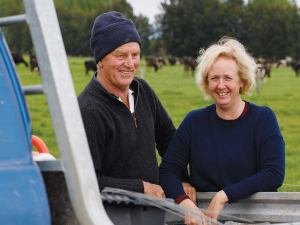Dairy sector profit still on the table, but margin gap tightens
DairyNZ’s latest Econ Tracker update shows most farms will still finish the season in a positive position, although the gap has narrowed compared with early season expectations.
 Corrie and Donna Smit are applying lessons from previous industry peaks and troughs at a time when many farmers are struggling to maintain profitability.
Corrie and Donna Smit are applying lessons from previous industry peaks and troughs at a time when many farmers are struggling to maintain profitability.
After 30 years’ dairying on the same Bay of Plenty farm, Donna and Corrie Smit have learnt lessons on weathering everything from devastating floods to milk price fluctuations.
As dairy farm costs climb ever upward, the Smits are applying their lessons from previous peaks and troughs at a time when many farmers are struggling to maintain profitability.
Farmers involved in DairyNZ’s Budget Case Study project, which includes the Smits, have experienced an average increase in operating expense over the past 2 years of an eye watering 23%, up from $4.34/kgMS to $5.35/kgMS*.
That $1.01/kgMS jump in costs has been covered by the rise in gross farm revenue of $1.26, most of this being needed to pay for the higher interest rates and living expenses.
Donna says she and Corrie have stuck to a “keep it simple” approach throughout their farming career.
At its core, and playing a key part in holding costs down, is the mantra to “grow more grass and turn it into milk”, capitalising on what will always be the lowest-cost feed source at hand.
That ability to maximise the cheapest feed possible has been aided by committing to the highest quality farm they could.
The free-draining productive flats around Edgecumbe were not the cheapest when they purchased their farm, but they’ve proven the most capable of generating quality grass.
Today, the property they’ve added to 14 times is “tidy but not highly automated”, reflecting their simple approach, she says.
Growing plenty of grass has enabled them to hold their farm working expenses (note, this excludes unpaid family labour and depreciation, which are operating expenses) at around $2.90/kgMS over the past few years, pushed up to $3.50/kgMS for the past year.
The usual suspects also appear on their list of increased costs, namely electricity, fertiliser, fuel, rates and supplement.
Their ability to adjust to rising farm costs stems from their second principle: to keep costs as variable as possible, rather than be lumbered with ongoing, fixed costs.
The Smits also work hard to minimise wasteful hidden costs throughout the farm operation. This demands a quick response to problems, whether it’s a leaky trough or lame cows, whereas leaving those problems results in a far greater expense later.
The Smits have also worked hard to build strong relationships with the businesses and suppliers they deal with, often for decades.
“In return, we do expect quality, service and cost effectiveness,” says Donna.
These open, well-founded relationships enable them to have honest conversations about price rises.
Future costs include emissions.
Donna and Corrie are tackling the future challenge of greenhouse gas emissions pricing in a manner that also fits with their low-cost, simple approach.
“We’re focusing on breeding better, lighter cows that deliver more kilograms of milksolids per kg of bodyweight, by moving from a Friesian herd to a cross-bred herd.
With no relief from cost rises appearing on the horizon, the Edgecumbe farm may be well positioned for a major shift in operations in coming years.
Their ability to move cows that are suited or not suited to such a system between the farms makes it an appealing option. Labour savings, and an interesting new way to continue dairying, are also attractive.
Donna sees robotic milking becoming a popular option, particularly on smaller North Island dairies, as aging owners look to stay engaged with farming but in a less physical way.
“We’re not quite there yet in terms of the capital cost, but I think it will be getting closer with the next generation of milking robots.”
When American retail giant Cosco came to audit Open Country Dairy’s new butter plant at the Waharoa site and give the green light to supply their American stores, they allowed themselves a week for the exercise.
Fonterra chair Peter McBride says the divestment of Mainland Group is their last significant asset sale and signals the end of structural changes.
Thirty years ago, as a young sharemilker, former Waikato farmer Snow Chubb realised he was bucking a trend when he started planting trees to provide shade for his cows, but he knew the animals would appreciate what he was doing.
Virtual fencing and herding systems supplier, Halter is welcoming a decision by the Victorian Government to allow farmers in the state to use the technology.
DairyNZ’s latest Econ Tracker update shows most farms will still finish the season in a positive position, although the gap has narrowed compared with early season expectations.
New Zealand’s national lamb crop for the 2025–26 season is estimated at 19.66 million head, a lift of one percent (or 188,000 more lambs) on last season, according to Beef + Lamb New Zealand’s (B+LNZ) latest Lamb Crop report.

OPINION: Your old mate welcomes the proposed changes to local government but notes it drew responses that ranged from the reasonable…
OPINION: A press release from the oxygen thieves running the hot air symposium on climate change, known as COP30, grabbed your…